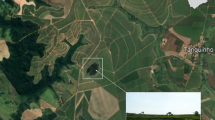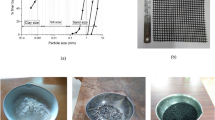Conclusions
-
1.
Two types of segregation are encountered when placing moraine soil in a dam: partial separation of large fractions, boulders and pebbles, occurs in the upper, “ry”, part of the layer when constructing dikes; under the water the finer fractions, clay, silt, and sand particles, separate. Both underwater and above-water segregation can be controlled to a certain extent.
-
2.
Segregation of moraine soil is most dangerous when placing fines-poor soil in thin layers: the boulders separated in the upper part (owing to the thinness of the water layer) can reach the base and form a lateral drain in the dam.
-
3.
The ability of soil to separate into fractions can be used for concentrating it at the borrow pit or when setting up reserve dumps (Fig. 5).
-
4.
When dumping under water there is an accumulation of the dispersed material, which can be used for connecting the earth structures with the concrete structures, for sealing the foundation, and for reducing seepage through the dam.
-
5.
To overcome the removal of the separated fine fraction when placing soil on a base not cleaned free from a boulder pavement, intense placement of the soil is recommended or, if the rate is sufficient, a) simultaneous dumping of 10–30 m3 of soil, b) a decrease of the height of the dumped layer, c) placement of clay soil, d) clearing the foundation under the downstream cofferdam-dike.
-
6.
At a head on the dam of up to 30 m the boulder pavement can be left in the foundation, if under it is dense moraine soil (or bedrock) and its thickness does not exceed 2 m.
Similar content being viewed by others
Literature Cited
A. F. Vasil'ev and K. V. Alekseev, “Construction of dams of moraine soils by dumping in water,” Gidrotekh. Stroitel'., No. 3 (1951).
G. A. Radchenko, “Natural segregation of dumped stone materials,” Gidrotekh. Stroitel'., No. 5 (1967).
S. G. Tsesarskii, “Sequence of hydroelectric stations on the Kovda River,” Gidrotekh. Stroitel'., No. 7 (1963).
A. F. Vasil'ev, “Deposition of soil in the base of hydraulic structures,” Gidrotekh. Stroitel'., No. 12 (1960).
Additional information
Continuation, for beginning see Gidrotekhnicheskoe Stroitel'stvo, No. 2, pp. 17–21 (1968).
Translated from Gidrotekhnicheskoe Stroitel'stvo, No. 4, pp. 27–30, April, 1968.
Rights and permissions
About this article
Cite this article
Bukin, P.A. Special features of the construction of dams of moraine soil at the hydroelectric stations of the Kovda multistage development. Hydrotechnical Construction 2, 316–320 (1968). https://doi.org/10.1007/BF02376424
Issue Date:
DOI: https://doi.org/10.1007/BF02376424




